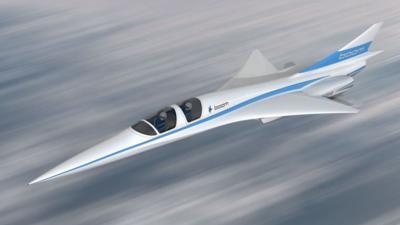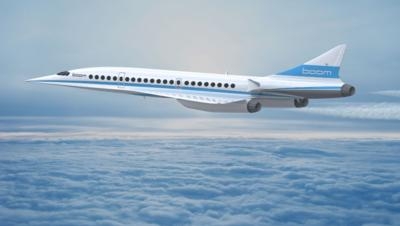Sir Richard Branson-Backed Company Hopes To Begin Subsonic Flight Testing In 2017
With a goal of developing the first supersonic passenger airliner for business travelers, Colorado startup Boom Technology has unveiled the XB-1 test airplane, a proof-of-concept aircraft that the company hopes will lead to a 45-passenger aircraft that would fly from London to New York City in a little over three hours.

The XB-1 Supersonic Demonstrator is a subscale prototype of the Boom supersonic passenger airliner. On display for the first time ever at Boom's Hangar 14 at Centennial Airport, the XB-1, nicknamed "Baby Boom," was unveiled Tuesday evening at an exclusive VIP event for airline and aerospace executives and media. The XB-1 is the world's fastest civil aircraft ever made, and it will demonstrate in flight the key technologies for affordable supersonic travel.
"60 years after the dawn of the jet age, we're still flying at 1960s speeds," said Blake Scholl, chief executive officer and founder of Boom. "Concorde's designers didn't have the technology for affordable supersonic travel, but now we do. Today, we're proud to unveil our first aircraft as we look forward to first flight late next year."
First flight of the XB-1 is planned for late 2017. Subsonic flight test will be conducted east of Denver; supersonic test flights will be conducted near Edwards Air Force Base in Southern California, in partnership with Virgin Galactic's The Spaceship Company. The XB-1 is a technically representative one-third-scale version of the production Boom airliner.
"I have long been passionate about aerospace innovation and the development of high-speed commercial flights," said Richard Branson, founder of Virgin Group. "As an innovator in the space, Virgin Galactic's decision to work with Boom was an easy one. We're excited to have an option on Boom's first 10 airframes. Through Virgin Galactic's manufacturing arm, The Spaceship Company, we will provide engineering and manufacturing services, along with flight test support and operations as part of our shared ambitions."
"The Boom airliner will be a core part of the intercontinental airline fleet," said Mike Boyd, Boyd Group International. "Travelers are hungry for faster flights and airlines will be excited for a differentiated and profitable option for their premium travelers."

The XB-1 Supersonic Demonstrator will fly with hardware from General Electric (engines), Honeywell (avionics), Tencate (carbon fiber), with composite structures fabricated by Blue Force. Final assembly and vehicle integration are taking place in Boom's facility at Centennial Airport.
"At Honeywell, we are inspired by Boom's vision of affordable supersonic travel. Honeywell is working closely with Boom on products ranging from avionics to air data in support of Boom's supersonic airliner and to fly on the the XB-1 demonstrator," said Carl Esposito, Vice President of Marketing and Product Management at Honeywell Aerospace.
Formerly of NASA, SpaceX and Boeing, Boom brought together the top minds in aviation to build its modern supersonic passenger airliner. Learning from the Concorde, they combined advanced aerodynamics, efficient engine technology and new composite materials to power a safe and affordable supersonic aircraft 2.6x faster than current jetliners.
The product of over 1,000 simulated wind tunnel tests, Boom's tri-jet design features a refined delta wing, a gracefully tapered carbon fiber fuselage, and efficient turbofan jet engines. Unlike Concorde, the Boom design requires no afterburner, significantly improving fuel economy.
(Images provided with Boom Technologies news release)
 ANN's Daily Aero-Linx (04.16.24)
ANN's Daily Aero-Linx (04.16.24) Aero-News: Quote of the Day (04.16.24)
Aero-News: Quote of the Day (04.16.24) Airborne 04.10.24: SnF24!, A50 Heritage Reveal, HeliCycle!, Montaer MC-01
Airborne 04.10.24: SnF24!, A50 Heritage Reveal, HeliCycle!, Montaer MC-01 Airborne 04.12.24: SnF24!, G100UL Is Here, Holy Micro, Plane Tags
Airborne 04.12.24: SnF24!, G100UL Is Here, Holy Micro, Plane Tags Airborne-Flight Training 04.17.24: Feds Need Controllers, Spirit Delay, Redbird
Airborne-Flight Training 04.17.24: Feds Need Controllers, Spirit Delay, Redbird




